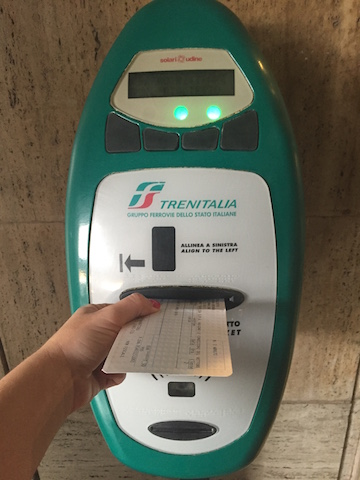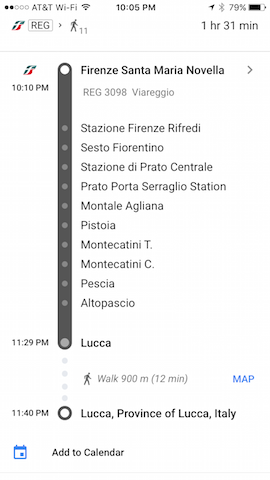Travel Tip: European Rail Travel 101
I’ve been riding a heck of a lot of trains these days. Many, many, many. But I’ve always been an avid rail passenger! I just love to see the countryside from the view of my comfortable train seat.
While the experience of figuring out train logistics could trigger a migraine for some, once you figure out the basic system for one major European rail network and central train station, the good news is that they’re all pretty similar to that base system.
What’s the “base system” you ask? Here you go —- European Rail Travel 101 coming at ya:
Step 1: Research Your Route
You’ll want to have an idea of the train routes/schedules before you head to the train station. Just use Google Maps (it’s now connected to most rail networks) and put in your starting location (i.e Firenze, AKA Florence) and your end destination, in my most recent case, Lucca. Make note of the departure times, routes, and for the route you select, how many stops between you and your destination, and if there are any transfers.
Pro Tips:
Sometimes Google Maps will pre-populate the rail station names, so just make sure you’re using the accurate rail station names you need for your journey.
Take a screen shot of the Google Map view (like I did below) so you don’t have to use cellular data at the train station!
Step 2: But Your Ticket
If you’re on a pretty common route with many departure times, I’d just buy your ticket at the rail station. But if you have a rare route, or a tight schedule, you might buy your ticket in advance online, but know that not all rail networks are set up for online ticket purchases yet, or you can buy it at the rail station in advance.
If you buy your ticket at the station either go to one of the ticket kiosk machines (which generally give you the option of English) or go to one of the helpful ticket agents and tell them about the ticket you want to buy, or have the route details written on a piece of paper.
When you’re buying your ticket you might have the option of a first class or second class train car (difference is in seat space, chair size, air conditioning – it will vary by rail network.) Sometimes there will be open seating, and sometimes you’ll be required to make a seat assignment before you board the train. The ticket kiosk or ticket agent will be able to give you instructions.
Step 3: Find Your Train Platform
Look for the giant reader board or TV monitors that display all train routes. Find your route on the board by looking for corresponding destinations, train number, departure time, etc. and then see what platform number your train has been assigned. Platforms are generally only assigned as you get closer to the departure time.
Important to note: the destinations listed on the reader board are the final stops on the train line. On my most recent trip, I was heading to Lucca but the train route to Lucca ends at Viareggio, so I looked for the train to Viareggio on the reader board to tell me what train platform I should go to to take the train to Lucca. I just got off at the Lucca stop. Ask a ticket agent for information on what destination to look for on the reader board if you’re not 100% certain. In this situation the final destination of the train line to Lucca (Viareggio) was included on my Google maps view (see above.)
Step 4: Validate Your Ticket
Every train station does this a little differently, but in general you need to insert your ticket into a machine that gives it a time stamp to indicate when it’s being used. This is especially important if you buy an open ticket — which is what I recently bought for my trip to Lucca. This is a ticket you buy for a specific day, but can use it on any time on that specific day. So by validating the ticket I’m saying “OK I’m using the ticket now!” Validation machines are generally located throughout a train station, adjacent to train platforms and near the ticket kiosks or counter. Here in Italy they’re often this bright green color.
Step 5: Get On The Train!
Head to your assigned train platform (look for the platform numbers) and then find your seat. The cabin class (first or second) are usually printed on the outside of the train car doors or just when you walk inside a train car. If you’ve been assigned a specific seat, your ticket will often have a train number, car number and then seat number. Try to enter the train as close to your car number as you can, otherwise you’ll end up carting your luggage through multiple train cars until you get into the correct train car. There are usually train operators near the platform you can ask for help.
Step 6: Enjoy The Journey!
I will often reference my Google notes to track the stops. For example, if I know I’m the 8th stop, I’ll follow the order of stops on my Google Maps screen shot with the stop signs I can see from my window every time the train stops. This helps me know when it’s getting close to my stop!
Other Pro Tips:
Keep your validated ticket handy. Often a train operator will come by and ask to see your ticket.
Watch your belongings very carefully at the train station, especially while you’re purchasing tickets. Confused tourists are an easy target!
Make sure you know the official name of the train station you’re leaving from and heading to. Your hotel can help clarify this. For example, the main train station in Florence, Italy is called “Firenze Santa Maria Novella,” but there might be a train station closer to your destination you should use.
Carting around a lot of luggage on a train can be a pain! So if you plan to take a lot of trains on your vacation, try to keep your roller luggage to a standard carry-on size. This size is much easier to navigate through aisles of the train cars.
While this is the basic structure of most European rail network and central train stations, every system is unique, so make sure you take the time to understand the train network you’re riding, the train station you’re departing from and arriving to, and arrive early to ask questions!
Safe traveling + cheers to ‘living big!’
Mary








